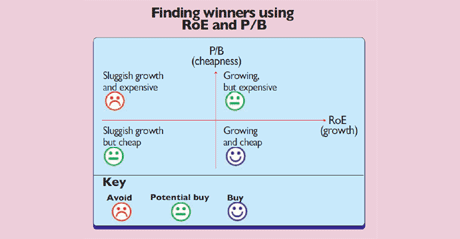Can you trust the mother of all ratios?
The return on equity ratio is highly favoured by professional stock pickers. It helps gauge a firm's profitability relative to size. But can you trust it? Tim Bennett explains.
Last Friday, Barclays' chief executive Bob Diamond warned that the bank might miss its 13% return on equity (ROE) target. Meanwhile, Credit Suisse has been explaining why it delivered an ROE of 6% in 2011, when its target is nearer 15%. And ROE is also one of US investor Warren Buffett's preferred numbers for analysing investments. The Financial Times even calls it the "mother of all ratios". But is it as useful as its fans claim?
Capturing bang per buck
ROE is an attempt to capture in one number the profitability of a firm relative to its size. Other ratios such as margins just deal with profitability. But that's not enough. If two firms make £100m of profits in a year and deliver margins of 20%, you might be equally impressed. But what if one employs £500m of capital and the other £1bn? Time for ROE.
How ROE works
The basic calculation takes profit after tax (or net income' in the US) and divides it by the total equity capital employed (also known as shareholders' funds). The answer is given as a percentage. Analysts argue about the calculation whether the equity capital employed figure should be taken from the end of the year, the start, or an average of the two.
MoneyWeek
Subscribe to MoneyWeek today and get your first six magazine issues absolutely FREE

Sign up to Money Morning
Don't miss the latest investment and personal finances news, market analysis, plus money-saving tips with our free twice-daily newsletter
Don't miss the latest investment and personal finances news, market analysis, plus money-saving tips with our free twice-daily newsletter
But provided the calculation is done consistently it doesn't matter. You could give the first firm's ROE as (£100m/£500m) x 100%, or 20% and the second as (£100m/£1bn) x 100%, or 10%. The first firm is now revealed as the clear winner. Or is it?
Ratios are useless in isolation
An ROE of 20% is a good start, but I need to know more. Comparing one investment to another is useful, as is comparing it to its sector and the wider market. Other benchmarks include the previous year (or better still, the last three to five years) and any target set by the directors. Why not combine ROE with the price-to-book (p/b) ratio? ROE may tell me I am getting a decent bang for my buck, but I need to know whether I am getting it cheaply too.
The golden grid
By combining ROE with the p/b ratio you can find stocks that are cheap. The p/b ratio compares a firm's market value to the book value of its balance-sheet assets the lower the result the cheaper the share and the ROE measures returns.
As the grid below shows, there are four possibilities. A high p/b ratio and low ROE stock is a dog it's not delivering returns and it's expensive. A stock with a low p/b and low ROE, however, is cheap and low growth, whereas a stock with a high p/b and high ROE is delivering returns, but isn't cheap. Either way, you should investigate whether the market has mispriced the growth potential (you can test this using other ratios such as the PEG).

The Holy Grail is a stock with a low p/b and a high ROE. These classic recovery plays aren't easy to find and can lead you into risky sectors (such as miners now). Nonetheless, the screen suggests these are stocks that have been beaten down by the market (hence the low valuation), but show strong signs of life (hence the high ROE).
So what's not to like?
ROE suffers one flaw that the banks exploited it largely ignores risk. A company may generate an ROE of 20%, but at what cost? If its cost of capital is 19%, are you still impressed? Worse, ROE is often backed by clever financial alchemy. This is where gearing comes in.
Take a firm with equity capital of £30,000 and debt (carrying an interest rate of 4%) of £970,000. Total capital employed is £1m. Say the directors boost assets by 1% the following year a gross return of £10,000, wiped out by interest of £38,800 (£970,000 x 4%). But what if they manage 7% instead? Now the gross return is £70,000 with an interest bill of £38,800. So the net return is £31,200, double the £30,000 of equity capital employed. There are also tax breaks on interest costs.
With no debt, those returns, both gross and net, would have been £10,000 and £70,000, or 1% and 7%. With debt they are -96% and +104%. Looking at ROE in isolation you can't tell how much debt is employed. But you need to highly geared firms are very risky. Last year a Bank of England report concluded that, via debt, the banks started "a highly competitive ROE race" in the 1970s that led to so many failing during the financial crisis. So what's an investor to do?
Promises, promises
First, don't believe any firm that offers you a double-figure ROE. As the FT's Martin Wolf notes, "at a 15% real return pretty soon bank equity would be the only real asset in the world". Next, never trust ROE alone. Study a firm's debt levels. Anyone who buys a share solely on the back of a high ROE should expect the mother of all headaches.
This article was originally published in MoneyWeek magazine issue number 576 on 17 February 2011, and was availableexclusively to magazine subscribers. To read all our subscriber-only articles right away, subscribe to MoneyWeek magazine.
Get the latest financial news, insights and expert analysis from our award-winning MoneyWeek team, to help you understand what really matters when it comes to your finances.
Tim graduated with a history degree from Cambridge University in 1989 and, after a year of travelling, joined the financial services firm Ernst and Young in 1990, qualifying as a chartered accountant in 1994.
He then moved into financial markets training, designing and running a variety of courses at graduate level and beyond for a range of organisations including the Securities and Investment Institute and UBS. He joined MoneyWeek in 2007.
-
 The new 4% rule – how much should retirees really draw from their pension in 2026?
The new 4% rule – how much should retirees really draw from their pension in 2026?Brits retiring in 2026 could be withdrawing too much from their pension pots if they stick to an old rule about ‘safe’ limits – with the risk of running out of money in retirement
-
 Leaving it too late to gift inheritances costs some of Britain’s wealthiest families £3m each
Leaving it too late to gift inheritances costs some of Britain’s wealthiest families £3m eachEven average Brits are being landed with huge and unexpected inheritance tax bills because of a little understood rule around gifting, new figures show